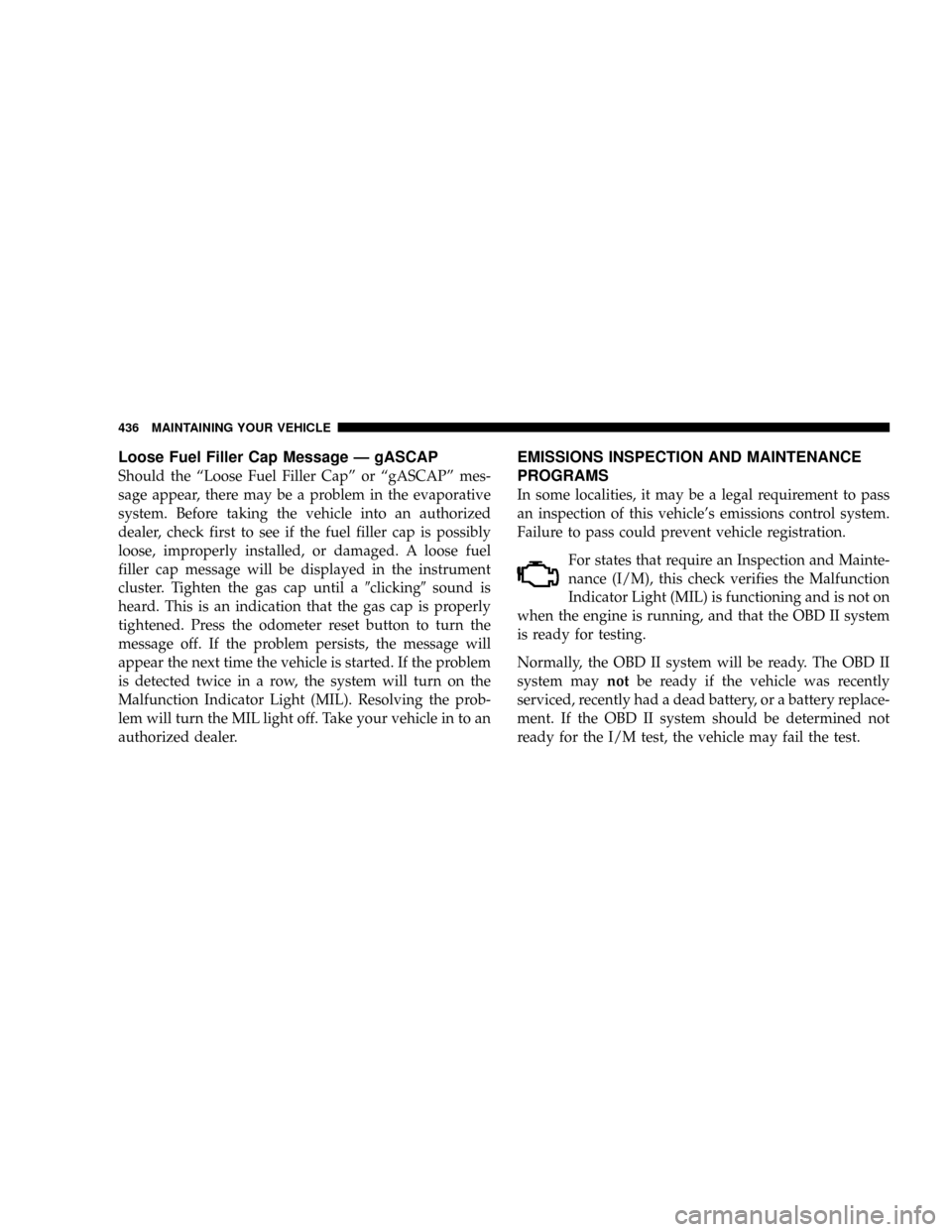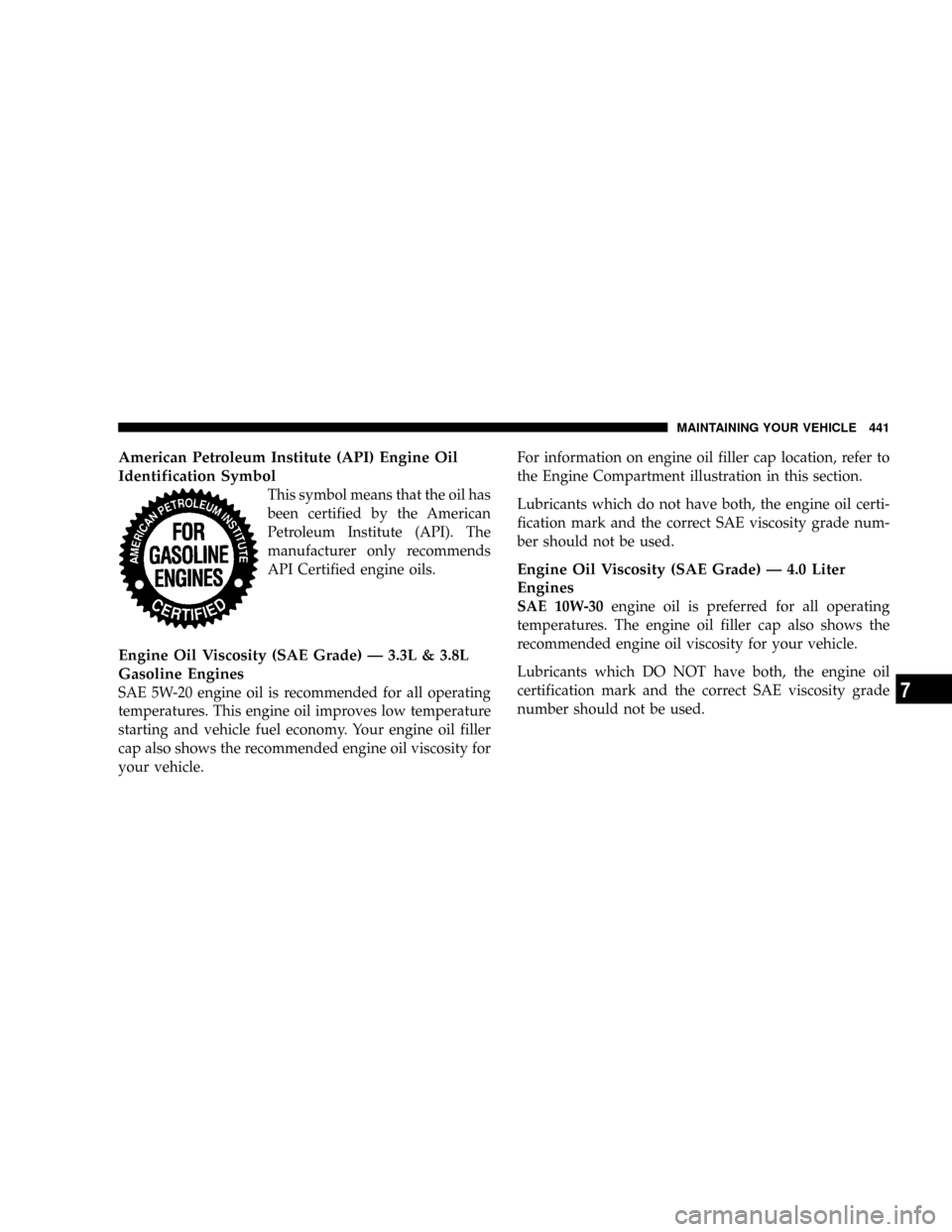Page 388 of 531
FLEXIBLE FUEL Ð 3.3L ENGINES ONLY
E-85 General Information
The information in this section is for Flexible Fuel Ve-
hicles (FFV) only. These vehicles can be identified by the
unique fuel filler door label that states:Ethanol (E-85) or
Unleaded Gasoline Only.This section only covers those
subjects that are unique to these vehicles. Please refer to
the other sections of this manual for information on
features that are common between Flexible Fuel and
gasoline only powered vehicles.
E-85 Fuel Cap
386 STARTING AND OPERATING
Page 389 of 531
CAUTION!
Only vehicles with the E-85 Decal and/or fuel filler
door label can operate on E-85.
ETHANOL FUEL (E-85)
E-85 is a mixture of approximately 85% fuel ethanol and
15% unleaded gasoline.
WARNING!
Ethanol vapors are extremely flammable and could
cause serious personal injury. Never have any smok-
ing materials lit in or near the vehicle when remov-
ing the fuel filler tube cap (gas cap) or filling the
tank. Do not use E-85 as a cleaning agent and never
use it near an open flame.
Fuel Requirements
Your vehicle will operate on both unleaded gasoline with
an octane rating of 87, or E-85 fuel, or any mixture of
these two.
E-85 Badge
STARTING AND OPERATING 387
5
Page 393 of 531

Gross Vehicle Weight Rating (GVWR)
The GVWR is the total allowable weight of your vehicle.
This includes driver, passengers, and cargo. The total
load must be limited so that you do not exceed the
GVWR.
Gross Axle Weight Rating (GAWR)
The GAWR is the maximum capacity of the front and rear
axles. Distribute the load over the front and rear axles
evenly. Make sure that you do not exceed either front or
rear GAWR.
WARNING!
Because the front wheels drive and steer the vehicle,
it is important that you do not exceed the maximum
front or rear GAWR. A dangerous driving condition
can result if either rating is exceeded. You could lose
control of the vehicle and have an accident.
Tire Size
The tire size on the Vehicle Certification Label represents
the actual tire size on your vehicle. Replacement tires
must be equal to the load capacity of this tire size.
Rim Size
This is the rim size that is appropriate for the tire size
listed.
Inflation Pressure
This is the cold tire inflation pressure for your vehicle for
all loading conditions up to full GAWR.
Curb Weight
The curb weight of a vehicle is defined as the total weight
of the vehicle with all fluids, including vehicle fuel, at full
capacity conditions, and with no occupants or cargo
loaded into the vehicle. The front and rear curb weight
values are determined by weighing your vehicle on a
commercial scale before any occupants or cargo are
added.
STARTING AND OPERATING 391
5
Page 431 of 531
MAINTAINING YOUR VEHICLE
CONTENTS
m3.3L Engine Compartment................432
m3.8L Engine Compartment................433
m4.0L Engine Compartment................434
mOnboard Diagnostic System Ð OBD II........435
NLoose Fuel Filler Cap Message Ð Gascap....436
mEmissions Inspection And Maintenance
Programs............................436
mReplacement Parts......................438
mAuthorized Dealer Service................438mMaintenance Procedures..................439
NEngine Oil..........................439
NEngine Oil Filter......................442
NDrive Belt...........................443
NSpark Plugs.........................443
NEngine Air Cleaner....................443
NCatalytic Converter....................444
NMaintenance-Free Battery................446
NAir Conditioner Maintenance.............448
7
Page 438 of 531

Loose Fuel Filler Cap Message Ð gASCAP
Should the ªLoose Fuel Filler Capº or ªgASCAPº mes-
sage appear, there may be a problem in the evaporative
system. Before taking the vehicle into an authorized
dealer, check first to see if the fuel filler cap is possibly
loose, improperly installed, or damaged. A loose fuel
filler cap message will be displayed in the instrument
cluster. Tighten the gas cap until a9clicking9sound is
heard. This is an indication that the gas cap is properly
tightened. Press the odometer reset button to turn the
message off. If the problem persists, the message will
appear the next time the vehicle is started. If the problem
is detected twice in a row, the system will turn on the
Malfunction Indicator Light (MIL). Resolving the prob-
lem will turn the MIL light off. Take your vehicle in to an
authorized dealer.
EMISSIONS INSPECTION AND MAINTENANCE
PROGRAMS
In some localities, it may be a legal requirement to pass
an inspection of this vehicle's emissions control system.
Failure to pass could prevent vehicle registration.
For states that require an Inspection and Mainte-
nance (I/M), this check verifies the Malfunction
Indicator Light (MIL) is functioning and is not on
when the engine is running, and that the OBD II system
is ready for testing.
Normally, the OBD II system will be ready. The OBD II
system maynotbe ready if the vehicle was recently
serviced, recently had a dead battery, or a battery replace-
ment. If the OBD II system should be determined not
ready for the I/M test, the vehicle may fail the test.
436 MAINTAINING YOUR VEHICLE
Page 443 of 531

American Petroleum Institute (API) Engine Oil
Identification Symbol
This symbol means that the oil has
been certified by the American
Petroleum Institute (API). The
manufacturer only recommends
API Certified engine oils.
Engine Oil Viscosity (SAE Grade) Ð 3.3L & 3.8L
Gasoline Engines
SAE 5W-20 engine oil is recommended for all operating
temperatures. This engine oil improves low temperature
starting and vehicle fuel economy. Your engine oil filler
cap also shows the recommended engine oil viscosity for
your vehicle.For information on engine oil filler cap location, refer to
the Engine Compartment illustration in this section.
Lubricants which do not have both, the engine oil certi-
fication mark and the correct SAE viscosity grade num-
ber should not be used.
Engine Oil Viscosity (SAE Grade) Ð 4.0 Liter
Engines
SAE 10W-30engine oil is preferred for all operating
temperatures. The engine oil filler cap also shows the
recommended engine oil viscosity for your vehicle.
Lubricants which DO NOT have both, the engine oil
certification mark and the correct SAE viscosity grade
number should not be used.
MAINTAINING YOUR VEHICLE 441
7
Page 488 of 531
FLUIDS AND CAPACITIES
FLUIDS AND CAPACITIES U.S. Metric
Fuel (approximate)
All Engines20 Gals 76 L
Engine Oil with Filter
3.3L and 3.8L (SAE 5W-20 API Certified) 5.0 Qts 4.7 L
4.0L (SAE 10W-30 API Certified) 5.5 Qts 5.2 L
Cooling System
3
3.3L, 3.8L and 4.0L (Use MopartAntifreeze/Coolant Five Year/
100,000 Mile Formula or equivalent.)13.4 Qts 12.6 L
3Includes heater and coolant recovery bottle filled to MAX level. Add 2.9 Qts (2.8 L) if equipped with a rear
heater
486 MAINTAINING YOUR VEHICLE
Page 489 of 531
FLUIDS, LUBRICANTS AND GENUINE PARTS
Engine
FLUIDS, LUBRICANTS AND GENUINE PARTS Ð ENGINE
Component Fluids, Lubricants and Genuine Parts
Coolant MopartAntifreeze/Coolant Five Year/100,000 Mile Formula HOAT (Hybrid Organic
Additive Technology) or equivalent
Oil ± 3.3L, 3.8L Use API Certified SAE 5W-20 engine oil. Refer to your oil filler cap for correct SAE
grade, meeting DaimlerChrysler Material Standard MS-6395.
Oil ± 4.0L Use API Certified SAE 10W-30 engine oil. Refer to your oil filler cap for correct SAE
grade, meeting DaimlerChrysler Material Standard MS-6395.
Oil Filter ± 3.3L, 3.8L Mopart4105409 or equivalent
Oil Filter ± 4.0L Mopar 5281090 or equivalent. Refer to your oil filler cap for correct SAE grade.
Spark Plugs ± 3.3L, 3.8L,
4.0LZFR5LP-13G (Gap.050 in / 1.27 mm)
Fuel ± 3.3L, 3.8L 87 Octane
Fuel ± 4.0L 87 Octane Acceptable Ð 89 Recommended
MAINTAINING YOUR VEHICLE 487
7